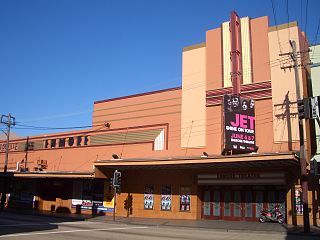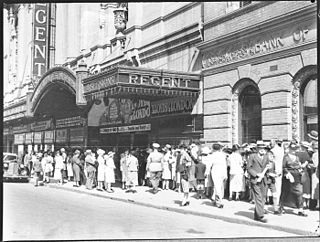
Potts Point is a small and densely populated suburb in inner-city Sydney, New South Wales, Australia. Potts Point is located 2 kilometres (1.2 mi) east of the Sydney central business district and is part of the local government area of the City of Sydney.

Kings Cross is an inner-eastern locality of Sydney, New South Wales, Australia. It is located approximately 2 kilometres east of the Sydney central business district, in the local government area of the City of Sydney. It is bounded by the suburbs of Potts Point, Elizabeth Bay, Rushcutters Bay and Darlinghurst.

Streamline Moderne is an international style of Art Deco architecture and design that emerged in the 1930s. Inspired by aerodynamic design, it emphasized curving forms, long horizontal lines, and sometimes nautical elements. In industrial design, it was used in railroad locomotives, telephones, toasters, buses, appliances, and other devices to give the impression of sleekness and modernity.

The Enmore Theatre is a theatre and entertainment venue in Enmore, New South Wales, Australia.

The Regent Theatre was a heritage-listed cinema and entertainment venue in George Street, Sydney, New South Wales, Australia, built in 1928 as a flagship for Hoyts, and was demolished in 1988 by property developer Leon Fink.

The El Rey Theatre is a live music venue in the Miracle Mile area of the Mid-Wilshire region in Los Angeles, California.
Australian non-residential architectural styles are a set of Australian architectural styles that apply to buildings used for purposes other than residence and have been around only since the first colonial government buildings of early European settlement of Australia in 1788.

The Eros Cinema is an Art Deco style cinema theatre located in Cambata Building at Churchgate, Mumbai, India. It has a seating capacity of 1,204 people per show.

The State Theatre is a 2034 seat heritage listed theatre located at 47–51 Market Street, in the Sydney central business district in the City of Sydney local government area of New South Wales, Australia. The theatre was designed by Henry Eli White with assistance from John Eberson and built between 1926 and 1929. It hosts film screenings, live theatre and musical performances, and since 1974 it has been the home of the annual Sydney Film Festival. It is also known as State Building and Wurlitzer Organ. The property is privately owned. It was added to the New South Wales State Heritage Register on 2 April 1999.
Aaron M. Bolot (1900–1989) was a Crimean-born architect. After migrating to Australia, Bolot contributed to and designed a number of historically significant buildings, including the Flats at Potts Point, registered with the Register of the National Estate for, among other things, its significance in the history of high rise design in Australia.

Moderne architecture, also sometimes referred to as Style Moderne or simply Moderne, Jazz Age, Moderne, Jazz Modern or Jazz style, describes certain styles of architecture popular from 1925 through the 1940s. It is closely related to Art Deco. Both belong to the architectural Modern Movement, which broke with tradition on purpose to create a fresh look that was uninfluenced by earlier forms and styles.

The Hollywood Theater is a historic theater building in Minneapolis which is listed on the U.S. National Register of Historic Places. It is located in the Audubon Park neighborhood of Minneapolis.

Rivoli Cinemas is an eight-screen multiplex in the Hawthorn East suburb of Melbourne. Noted for its Art Deco architecture, the cinema was first built in 1940, and reopened as a multiplex in 2000 following a renovation and expansion.

Kenilworth is a historic house in the Sydney suburb of Potts Point, New South Wales, Australia. Completed in 1869 in the Victorian Rustic Gothic Revival style, the sandstone house is now part of St Luke's Care.

The Ritz Cinema, also known as the Ritz Theatre, is a heritage-listed cinema located at 43 St Pauls Street, in the Sydney suburb of Randwick in the City of Randwick local government area of New South Wales, Australia. It was designed by Aaron Bolot and built in 1937 by C. & B. J. Williams. It was added to the New South Wales State Heritage Register on 2 April 1999. The architect, Aaron Bolot, is known for his classic art deco buildings throughout Sydney, such as his commissions for grand apartment buildings in Potts Point.

Gowrie Gate is an Art Deco building located at 115 Macleay Street, Potts Point, Sydney, Australia. Situated on the south-west corner of Macleay Street and Orwell Street it was designed by Architect, Dudley Ward and built by S.D.C. Kennedy & Bird Pty. Ltd with building works completed in 1938. The building was sold in its entirety for £80,000 in 1939. The spread of flats in the 1920s and 30s was one of the most marked developments in Sydney housing. Flat development was booming along with population and the area exhibited a concentration of Sydney buildings designed in the Art Deco style. Ward's influential designs for both this building and The Wroxton apartments, looked to European experiments, picking up on innovations in public housing in Germany and Holland. The building consists of 7 floors and a basement. It is constructed in an Art Deco style from red textured brick. When completed the building consisted of 53 self contained flats, four penthouses, two professional suites and six shops facing Macleay Street and Orwell Streets. The building originally featured a number of open balconies on the Orwell Street facade, but many of these have been infilled over the years to provide more living space. The entry foyer and ground floor retains some original features such as a large hanging lantern along with sections of original walnut paneling. Although not heritage listed the building is a contributory item within the Potts Point/Elizabeth Bay Heritage Conservation Area.
Abacus Group is a ASX 200 public listed company that specialises in investing in Australian Real estate investment trusts with an investment portfolio concentrated in the Office and Self Storage sectors. They manage legacy investments in property developments. The company was known as Abacus Property Group until August 2023, when they split off their self-storage business, Abacus Storage King.

















